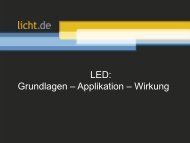licht.wissen No. 09 “Refurbishment in Trade, Commerce and Administration“
An extensive survey of offices, workshops and school classrooms shows that lots of lighting installations are obsolete. licht.wissen 09 informs that refurbishment sustainably lowers energy consumption, saves costs and makes for a significant improvement in lighting quality. This booklet from licht.de contains impartial advice for consultations with commercial clients. It also flags up web tools for assessing lighting installations and making design recommendations. Free Download at www.licht.de/en
An extensive survey of offices, workshops and school classrooms shows that lots of lighting installations are obsolete. licht.wissen 09 informs that refurbishment sustainably lowers energy consumption, saves costs and
makes for a significant improvement in lighting quality.
This booklet from licht.de contains impartial advice for consultations with commercial clients. It also flags up web tools for assessing lighting installations and making design recommendations. Free Download at www.licht.de/en
Create successful ePaper yourself
Turn your PDF publications into a flip-book with our unique Google optimized e-Paper software.
licht.wissen 09
Refurbishment in Trade, Commerce and Administration
Vertical illuminance
Examination and treatment rooms are viewed for lighting
purposes like the equivalent rooms in a hospital. They
should additionally have an agreeable, homely atmosphere.
In general medical treatment rooms, visual communication
between doctor and patient is a priority. Good vertical
illuminance on faces is important here. Suspended LED
task zone luminaires are a good choice. At the treatment
couch, supplementary lighting needs to be provided to
deliver the 1,000 lux required. Dimmable luminaires are
recommended here: in dimmed operation – e.g. at
20 percent – they help provide agreeable general lighting;
set for full output, they deliver the light needed for
examinations and treatment.
Depending on requirements, a separately switched
examination light should be provided.
35
Doctor’s surgery lighting
Reception area, consulting room, examination room – lighting for a doctor’s surgery needs to meet a range of
requirements. Tailored design ensures that the right light is available for all visual tasks and that patients feel they
are in good hands.
Lighting design for a doctor’s surgery has
two defining aspects. First of all, physicians
and surgery staff require optimal functional
light for the work they perform in treatment
rooms, at VDU workplaces and in the
laboratory. Secondly, waiting areas and
consulting rooms should have a lighting
atmosphere that patients find reassuring
and re laxing. With flexible LED systems
and comfortable lighting control, lighting
concepts can be easily and efficiently
implemented for diagnosis, therapy and
wellbeing.
Reception and waiting room
The reception is the calling card of a doctor’s
surgery. It makes the first impression
on the patient and, at the same time, constitutes
a workplace for receptionists.
Bright, uniform, cheerful lighting is correct
here. For work at the computer, VDU workplace
stipulations require at least 500 lux
and freedom from glare.
30
Good reading light for waiting areas is provided
by suspended luminaires – if necessary
supplemented by wall luminaires for direct/indirect
light distribution – delivering
300 lux illuminance. Accents can be set by
e.g. coloured light from diffuse LED light
tiles.
Treatment rooms
In the consulting room, physician and staff
need good general lighting with a uniform
500 lux illuminance as well as flexible lighting
for examinations. Where an intelligent
control system is installed, the lighting can
easily be switched and dimmed to the
optimal illuminance, which can range from
5 lux, e.g. for special eye and ear examinations,
to several thousand lux. Very good
colour rendering – at least R a M 90 – is
obligatory.
Bright LEDs are increasingly the light
source of choice for examination rooms.
Their advantages here are their longevity
– which keeps maintenance to a minimum –
their low heat gain and the possibility of
integrating LEDs of different colour temperatures
in a single luminaire. This colour
mix offers the option of varying light colour
at the push of a button or by remote control
to suit the examination in question: neutral
white for general examinations, for example,
warm white light for assessing the condition
of skin, cool white light for quickly
identifying blood vessels. Minimum lighting
requirements are set out in DIN EN 12464-1
and DIN 5035-3.
More information on the subject can
be found in the booklets licht.wissen 07
“Light as a Factor in Health” and licht.wissen
17 “LED – The Light of the Future”.
[35] In a treatment room, good light is
needed for examinations, communication between
doctor and patient and VDU work.
[36] Coloured light in the waiting area
makes for a greater sense of wellbeing and
can help patients relax.
















